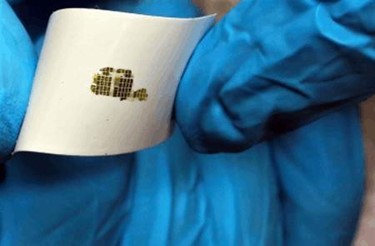Air Force Makes First Flexible RF Gallium Nitride Devices
By Jof Enriquez,
Follow me on Twitter @jofenriq

Scientists at the Air Force Research Laboratory (AFRL) report a breakthrough in materials science used to create flexible antennas and devices: a viable method to grow and transfer the exotic material known as Gallium Nitride (GaN) in a soft and flexible substrate.
Wireless devices today use Gallium Arsenide, or GaAs, (an older material co-developed by AFRL researchers) to amplify signals. However, GaAs is poor in transmitting high frequency signals at high power, resulting in slow data transfer rates. As a replacement, scientists are looking at Gallium Nitride, a newer material that overcomes Gallium Arsenide's limitations, and often is used in high performance amplifiers or as a component of radar and wireless systems.
Even though it is foreseen as a major component in 5G mobile wireless infrastructure and RF high-power semiconductors, GaN has not achieved wide application yet because it requires, among other things, a rigid substrate such as sapphire, and typically is produced in flat forms not amenable to bending or flexing.
Now, AFRL researchers say they have developed a novel technique of producing and transferring GaN to a flexible substrate. Specifically, they grow the GaN on a material called boron nitride, which forms chemical bonds with the growing surface. These bonds are weak enough to allow the transfer of the apparatus successfully.
"For the first time, strainable high-frequency RF GaN devices are demonstrated, whose exceptional performance is enabled by epitaxial growth on 2D boron nitride for chemical-free transfer to a soft, flexible substrate," the researchers wrote in Advanced Materials.
"We are the first group ever to demonstrate a flexible RF (radio frequency) transistor device based on Gallium Nitride that actually performs under strain and is flexible, which is quite powerful,” said Nicholas Glavin, a research scientist at the AFRL Materials and Manufacturing Directorate.
In other words, by embedding GaN transistors in wireless devices of non-flat shapes and tinier sizes, the touted potential of GaN as a compact, yet high-performance, alternative to silicon-based transistors is fulfilled.
"It’s been a big DOD priority to further develop this material," said Dr. Donald Dorsey, the lead for the Agile Radio Frequency Electronic Materials and Processes Team. "We are the first to demonstrate a flexible RF transistor device using Gallium Nitride that maintains high quality performance under strain using the transfer method. We now have the potential to create high frequency transmitters for high power communications and radar that use Gallium Nitride in a more compact and versatile form. This is a tremendous advance in the science."
The Air Force sees many primary applications for their scientists' breakthrough. One is the production of GaN-based flexible transmitters in wearables and sensors that collect and pass data more efficiently. Another is the development of flexible and conformal radar technology adaptable to dynamic environments, to replace typical radar systems that are big and bulky. Yet another advantage is the ability to shorten antenna transmission by installing flexible GaN power transmitters adjacent a radar antenna on a single platform.
AFRL is among those at the forefront of cutting-edge research in antenna design and miniaturization. Before this announcement of the use of GaN in flexible RF devices, its researchers recently unveiled ultra-compact antennas that are 90 percent smaller than state-of-the art compact antennas.
